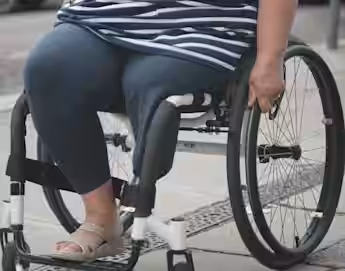In 2017, our client Tracey Gray had to undergo a transformal (above knee) amputation following misdiagnosis and inaction from staff first at the Hereford County Hospital A&E Department, and then at the Worcestershire Acute Hospital (WAH).
Tracey, now 59, first went to her GP in 2016 with a painful and swollen left big toe. She was told it was likely a chilblain. Over the next six weeks, the pain got worse and Tracey was referred for an MRI and review by a private orthopaedic foot surgeon, who reported no orthopaedic abnormality but arranged a vascular referral and some more blood tests.
In the meantime, the swelling extended to Tracey's left calf and the pain got progressively worse. While attending Hereford County Hospital for blood tests, the pain became so bad it left her crying, shaking and unable to walk. She was diverted to A&E where doctors suspected a deep vein thrombosis (DVT). Tracey was in fact suffering limb ischaemia and the severe pain was because her circulation was being damaged by the ischaemia. She needed an urgent vascular review and action to restore her circulation.
Eventually, as the pain became unbearable, and she could no longer move at all, Tracey's GP arranged her admission to WAH and heparin was administered. She was diagnosed as having thrombosis and prepared for thrombectomy and stent surgery, to restore circulation to the leg. This surgery failed because there was inadequate management of her heparin levels during the operation. Further delays in recognising that the operation had failed, and that Tracey was also developing a reperfusion, occurred.
Ultimately, Tracey experienced ischaemia of her leg, in which the tissue effectively dies, because it has no blood flow. The only solution is amputation.
Once she was discharged home to her husband and two sons, she and her family decided to investigate a medical negligence claim regarding her treatment and the repeated failure to react to clear signs of limb ischaemia.
Once Caron Heyes and Jamie Green took on Tracey's claim, they sent Particulars of Claim to both trusts. The first defendant (Hereford County Hospital) admitted that if the Tracey had been seen immediately by, a vascular surgeon who had investigated properly, disease in the common iliac artery would probably have been confirmed and treated with heparinisation and antiplatelet medication with an endovascular stent. This in turn would probably have prevented further embolization and avoided amputation. While both defendants denied that they had failed in their care, at a settlement meeting four years after the amputation, they made an offer of settlement that reflected the very strong case we had built, and the high risk to them of losing at trial. Tracey accepted settlement from both trusts.
Watch Tracey's story and her determination to move forward with her life following settlement.
Contact us
For further information about misdiagnosis claims and amputation claims, please call Caron Heyes on 03304606743 or email caron.heyes@fieldfisher.com, or call Jamie Green on 03304606771 or email jamie.green@fieldfisher.com.
Alternatively
- You can speak to our medical negligence solicitors on freephone 0800 358 3848
- email us: personalinjury@fieldfisher.com
- Complete the short online enquiry form
All enquiries are completely free of charge and we will investigate all funding options for you including no win no fee. Find out more about no win no fee claims.


